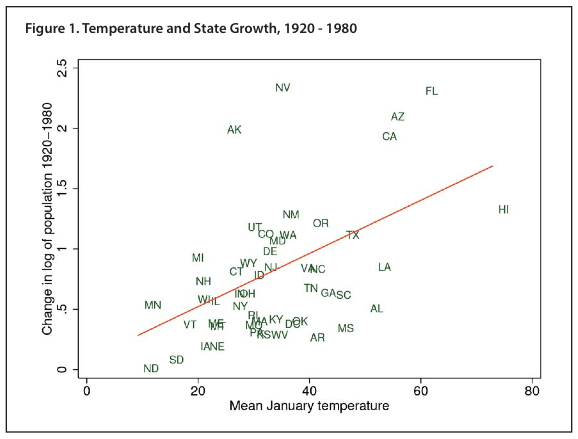Aaron Renn, aka the Urbanophile, asked an interesting question on Twitter today as we look down the barrel of another heavy snow: "how does this winter affect perceptions of the city's desirability to live in?"
As a Southerner, I'd protest that we're at a disadvantage because it's hard to headline the grinding oppressiveness of the summer down there—you can put on as much clothes as you want, but you're legally limited on how much you can take off. And when Chicago gets as hot as it is in Baton Rouge, you'll be mad you moved to Houston. Or your grandkids will, at least, as they pack their bags for sunny, mild Edmonton.
Still, point taken. Renn pointed me towards the work of Edward Glaeser, the Harvard economist and U. of C. grad who's become one of the most prominent analysts of the American city in the 21st century. And he thinks there's a strong correlation. He's got a whole paper on it, in fact: "Smart Growth: Education, Skilled Workers, & the Future of Cold Weather Cities."
Cities with average January temperatures under 30 degrees Fahrenheit grew in population only one-third as quickly from 1960 to 1990 as did cities with average January temperatures above 50 degrees. The shift of population toward the Sun Belt can also be seen at the state level: while population in the colder 25 states grew 95 percent between 1920 and 1980, the warmer 25 states saw their average population grow 309 percent.
It looks a bit like this:

Glaeser argues that, once the South became functional with the advent of air conditioning and cars—in essence, outdoors-avoidance technologies—people flocked to warmer climes: "Seen over the long term, the invention of air conditioning and medical advances against tropical diseases tilted growth toward warmer metropolitan areas. Meanwhile, as transport costs have fallen, the proximity of 'cold' states to rivers and ports has become less important, and places oriented to consumers have grown relative to places organized around production."
I don't think Glaeser is wrong, necessarily, but I think it's an incomplete picture.
Air conditioning isn't the only technology that brought prosperity to the South. It kind of needed all the technologies, which it got much later than the North. Take, for instance, this map of electricity use in 1921, which the Atlantic's great Alexis Madrigal found. This is what the country looked like, technologically speaking, when Glaeser's measurement of state growth begins:
.jpg)
The South lagged far behind the North in industrialization, a process that began with the institution of slavery (and the devastation of the Civil War, to which the South's lack of industry contributed) and continued well after its passing with the rise of the sharecropping economy, something I've written about at length.
Low-wage industrial monocultures make industrialization—and the skills and education required for it—a low priority. Beyond that, they actively discourage technological advancements: "The planters and employers who dominated regional politics were well aware that education greatly increased the probability that a young person would leave both the home county and ultimately the entire region," explains Gavin Wright.
Southern labor and economic policies suppressed economic growth, at the level of both business and government, well into the 20th century, creating an economic vacuum. Ross Perot famously described the effects of the North American Free Trade Agreement as a "giant sucking sound." Once the South let up off its own vacuum, it created a massive competitive advantage with Northern states. The North then had to compete with something like a third-world country within its own borders. (As for the westernmost parts of the Sun Belt, being the port of call for migrants coming in the other direction has its benefits.)
"One new factor common to the post-war South was the all-out effort to attract business through tax breaks, municipal bonds for plant construction, industrial development corporations, research parks, and expenditures on publicity far beyond other regions. Historian James C. Cobb (1982) called it The Selling of the South. Abolishing the low-wage sectors eliminated the vested interest in isolation; once the doors were flung open, the rush of absorption into the national economy was breath-taking, according to Wright.
(Ironically, given the anti-federal sentiments of the South, Wright attributes some of the region's rise to federal minimum wage laws and other New Deal and Great Society initiatives that forced a more level playing field across the Mason-Dixon. Glaeser tends to credit things like right-to-work laws.)
In short, there's something of a chicken-and-egg question with the air-conditioning solution that Glaeser cites. Adoption of air conditioning, across the South, was slower than you might expect from the weather. Its availability is a well-established boon to the South, but so is being able to power and afford air conditioning.
It's significant that Enrico Moretti, like Glaeser an economist interested in how knowledge workers cluster in cities and regions, has most recently turned his focus back to the Tennessee Valley Authority. That's a government project so ingrained in Southern culture that, as a kid, I thought that the Tennessee River was just called the TVA (emphasis mine):
We find that the TVA’s direct productivity effects were substantial. The investments in productive infrastructure resulted in a large increase in local manufacturing productivity, which in turn led to a 0.3% increase in national manufacturing productivity. By contrast, the indirect effects of the TVA on manufacturing productivity were limited. While we do find strong evidence of localized agglomeration economies in the manufacturing sector, our empirical analysis clearly points to a constant agglomeration elasticity. When the elasticity of agglomeration is the same everywhere in the country, spatially reallocating economic activity has no aggregate effects, as the benefits in the areas that gain activity are identical to the costs in areas that lose it. Thus, we estimate that the spillovers in the TVA region were fully offset by the losses in the rest of the country.
The intensely regressive economic (and cultural) practices of the South damned up potential across its old borders; once they began to fall, it created a flood, draining Yankee knowledge, technology, and workers.




